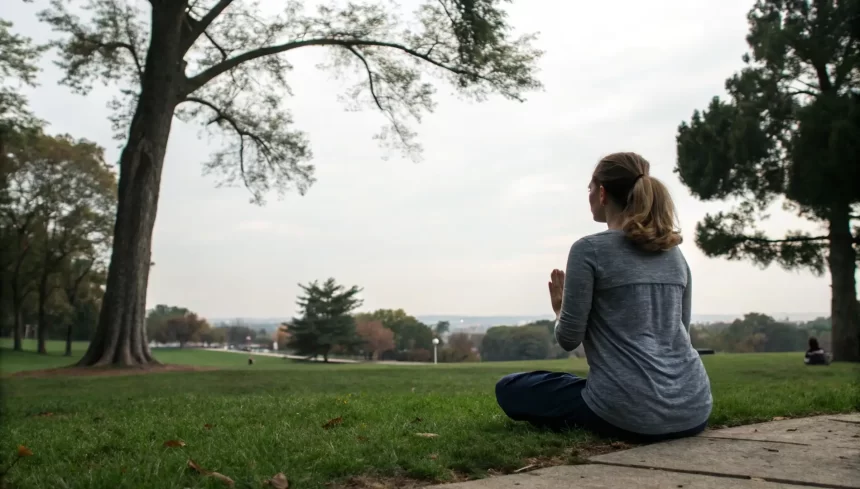Mindfulness is one of the basic human abilities to live in the moment. Mindfulness means being fully aware of where we are and what we are doing. Negative thoughts can often interfere with this awareness. Mindfulness meditation is a type of meditation that helps us to increase our awareness of what we are feeling in the moment, without having to involve our minds in analyzing and interpreting those situations. Mindfulness meditation uses exercises to increase mindfulness, including proper breathing techniques, guided imagery, and other exercises to calm the mind and body, reduce negative thoughts, and help reduce stress and anxiety. In this article, you’ll learn everything you need to know to get started.
Mindfulness meditation is a powerful tool for managing stress and improving mental health. It teaches us to respond to life’s challenges with clarity and calmness.
Dr. Jon Kabat-Zinn, founder of Mindfulness-Based Stress Reduction (MBSR)
What is Mindfulness Meditation?
Meditation, simply put, is a method to train the mind. Often, our thoughts wander to various places. Sometimes, we think about the future, or we might dwell on the past. Worrying about uncertainties and daydreaming can also occupy our minds. By practicing meditation, we refocus on the present moment. This practice equips us with tools to reduce tension and anxiety, fostering peace and kindness toward ourselves and others.
Why is Mindfulness Meditation So Popular in the U.S.?
- Stress Reduction:
- A 2023 study by the American Psychological Association found that mindfulness practices significantly reduced stress levels in adults.
- With burnout and anxiety on the rise, many Americans are turning to mindfulness as a quick and accessible way to de-stress.
- Mental Health Benefits:
- Mindfulness has emerged as a highly effective tool in managing a variety of mental health challenges, including anxiety, depression, and post-traumatic stress disorder (PTSD). By fostering a sense of awareness and acceptance, it helps people break free from the cycles of negative thought patterns that often exacerbate these conditions.
- For those struggling with anxiety, mindfulness promotes focus on the present moment and reduces worry about future uncertainties. In cases of depression, it encourages nonjudgmental awareness of emotions and helps people avoid feeling overwhelmed by their thoughts. PTSD sufferers have also found relief through mindfulness techniques that gently ground them in the present moment, reducing triggers and flashbacks.
- Thanks to the growing popularity of apps like Calm and Headspace, incorporating mindfulness into daily routines has become more accessible than ever. These platforms offer guided meditations, breathing exercises, and mindfulness challenges tailored to different needs, making it easier for people to experience the mental health benefits of mindfulness.
- Improved Focus:
- In today’s world of constant digital notifications, emails, and social media, staying focused can seem like a daunting task. Through regular practice, people develop the ability to resist distractions and fully engage in the tasks at hand.
- Research has shown that mindfulness improves cognitive flexibility and strengthens the neural pathways associated with sustained attention. Professionals often report increased productivity, while students find it easier to absorb and retain information. Mindfulness is truly a game-changer in a distraction-filled environment.
- Holistic Wellness Movement:
- Over the past decade, there has been a significant shift in how Americans approach health, with many moving toward more holistic and integrated wellness practices. Mindfulness is at the heart of this movement by bridging the gap between mental and physical health. Unlike quick fixes or isolated interventions, mindfulness creates a deep connection between mind and body, creating a sense of balance and harmony.
How to Start Mindfulness Meditation
Getting started is simpler than you might think. Here’s a step-by-step guide:
- Find a Quiet Spot: Choose a place where no one will disturb you. It could be your living room, a local park, or even your car on your lunch break.
- Set a Timer: Start with just 5 minutes and gradually increase the time until you get used to it and it is comfortable for you.
- Adopt a Comfortable Position:
- Sit on a chair with your feet flat on the ground, or cross-legged on a cushion.
- Keep your back straight but relaxed.
- Focus on Your Breathing:
- Pay attention to the sensation of your breath entering and leaving your body.
- If your mind wanders (and it will), gently bring your focus back to your breath.
- Use Guided Meditations:
- Beginners often benefit from guided sessions available on apps like Insight Timer, Calm, or YouTube.
Tips for Staying Consistent
- Start Small: It’s better to meditate for 3 minutes daily than to aim for 30 minutes and give up after a week.
- Pair It With an Existing Habit: For example, meditate right after brushing your teeth or before your morning coffee.
- Join a Community: Look for local meditation groups or online forums for support and accountability.
- Be Kind to Yourself: Don’t stress if you miss a day or get distracted during meditation. It’s all part of the process.
Mindfulness in Everyday Life
- Meditation is not the only way to practice mindfulness. Here are some ideas for incorporating mindfulness into your day:
- Mindful Eating: Savor each bite of your meal, noticing the flavors, textures, and aromas.
- Mindful Walking: Pay attention to the sensation of your feet touching the ground and the rhythm of your steps.
- Mindful Listening: Pay close attention when someone is talking to you. Instead of planning what you’re going to say next, focus on their words and try to understand them completely.
The Science Behind Mindfulness Meditation
Scientists have discovered amazing benefits of mindfulness. Research at places like Harvard and Johns Hopkins shows that mindfulness meditation can:
– Reduce stress by reducing the amount of cortisol (stress hormone) in the body.
– Improve your brain’s ability to learn, remember things and manage emotions.
– Strengthen your immune system and help your body health.
Common Myths About Mindfulness Meditation
- “I need to clear my mind.”
Not true. Mindfulness is about observing your thoughts, not eliminating them.
- “I don’t have time.”
Even a minute of mindfulness can make a difference. Try meditating during your morning commute or while waiting in line.
- “It’s only for spiritual people.”
While mindfulness has roots in Buddhism, it’s a secular practice that anyone can adopt.
Conclusion
Mindfulness meditation is a simple practice with many benefits. It helps you manage stress better, think more clearly, and feel more balanced in your daily life. You don’t need to be perfect from scratch, just start with small steps and keep going. Over time, you will notice how it makes your life calmer and happier. Remember, mindfulness is not an end goal. Mindfulness meditation is about enjoying the process of being present every day.











Sed non mi hendrerit, bibendum sem et, vestibulum mi. Quisque libero enim, porttitor sit amet pellentesque nec, vehicula vitae erat. Aliquam erat volutpat.
Curabitur sit amet eleifend ex, sed dapibus ligula. Proin efficitur turpis a purus suscipit iaculis.
Integer auctor porttitor sapien non commodo.
Your article helped me a lot, is there any more related content? Thanks!